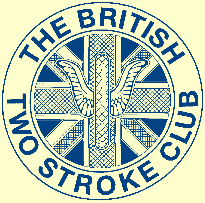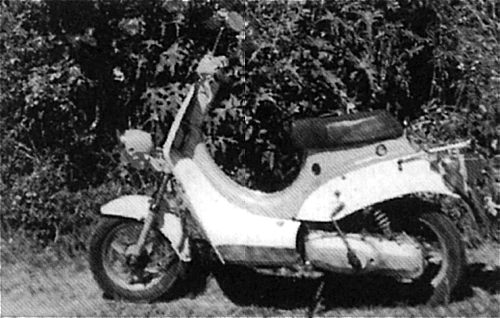 Go
to the Archive index
Go
to the Archive index
As I already had the D7 and the JIl (Bantam and James) I was not going to get another bike because I had not got room for one. The only space left was in the former coal shed and you couldn't get a bike in there. However, when visiting a friend recently I found that he had a scooter that he wanted to get out of the way and, after a brief trial, I bought it regardless. The machine in question is a 1981 Suzuki FS50, which came complete with a shopping basket over the front wheel. It is so small that you could get three of them into the aforementioned coal shed.

Why did I buy it? It is hard to explain but it was probably due to the fact that I have seen machines like this buzzing around delivering pizza, among other things, and wondered how they were constructed. Also whilr riding the Comet I have had some epic races with them and found that they are no slouches. With their automatic transmission, they are quicker off the mark and up to about 30mph than the James but the raw power of the 98cc Mark 4 Villiers engine then enables me to pass them. I was very keen to find out how the transmission works, apart from anything else, and thought that it must be something like a tbree-speed bicycle hub.
My acquisition wasn't in bad condition and had only done 1,600 miles (this time round) and a quick look indicated that it was in surprisingly good order. Parts of the self destructing plastic bodywork had to be reinforced but that seemed to be all the urgent work needed. At first I couldn't figure out where things were but decided to start by changing the oil in the transmission case. This wasn't too hard as cast in the case were the words: drain plug, level plug and 800ml. So how much is a ml? It must be pretty small it will take ages to measure out 800 of them. Fortunately, I discovered that the equivalent of 800ml is about 1 pint so that's what I put in and topped it up to the level. When filling the gearbox on the Comet, you can do without the calculator. You never drain it because there is no drain plug. All that it needed is to top it up to the level. Later at the Kempton Park (Surrey) show and autojumble I was able to buy a workshop manual for the FS50. This proved to be just what was needed and it is a revelation because it is so clear and comprehensive. I had previously found the oil tank and now found the oil pump and not having knowingly seen such a system before, I suddenly understood what a convenience oil injection would be. I also found the carburettor and was amazed to see that it has a pilot jet, an air adjusting screw and a throttle stop. No expense spared here either, unlike the Comet, which only has a throttle cable adjuster.
Then I looked at the electrics. I had previously noticed that the flywheel cover had not been off for years and thought that the points must be in a bad way. Now I know why the cover has not been off. There aren't any points, it has electronic ignition. It also has a locking ignition switch, a battery and a trickle charger, flashers, horn, stop light, and a parking or 'City' light. Both the machines have direct main lighting but the 'City' light on the Comet was a small dry battery and a 0.3 amp torch bulb with no other original electrical equipment apart from the ignition. There was no speedometer, steering lock, toolkit or mirror on the Comet either.
Now to the transmission. This consists of three sets of reduction gears, two centrifugal clutches, one chain and a freewbeel all in one case and it works a treat but don't ask me how. The Comet on the other hand only has a primary chain and clutch, a small layshaft, one sliding dog and a rear chain. Something that the FS50 manual does not tell you is what to do if the throttle gets stuck open on Putney Bridge in the rush hour.
These oriental scooters are a real 'box of tricks' but because they are well-engineered they are trouble-free and long lasting. However spares are more or less non-existent for the older bikes and they are, in the end, throw-away machines. Looking at this scooter has made me appreciate the Comet all the more. With its utrer simplicity it will go on for ever. Regrettably, no modern manufacturer would last very long if it made Comet-type machines, whereas they sell Suzuki-type machines in vast numbers, which, I suppose, answers the question "How can they make them at the price?" and the shopping basket gives a clue as to the nature of the buyers. Come to that, the specification of the 1954 Comet gives one a pretty clear idea of the impoverished state of its original owners.
This article was first published in the Sepember/October 1995 edition of The Independent, the magazine of the British Two-Stroke Club.